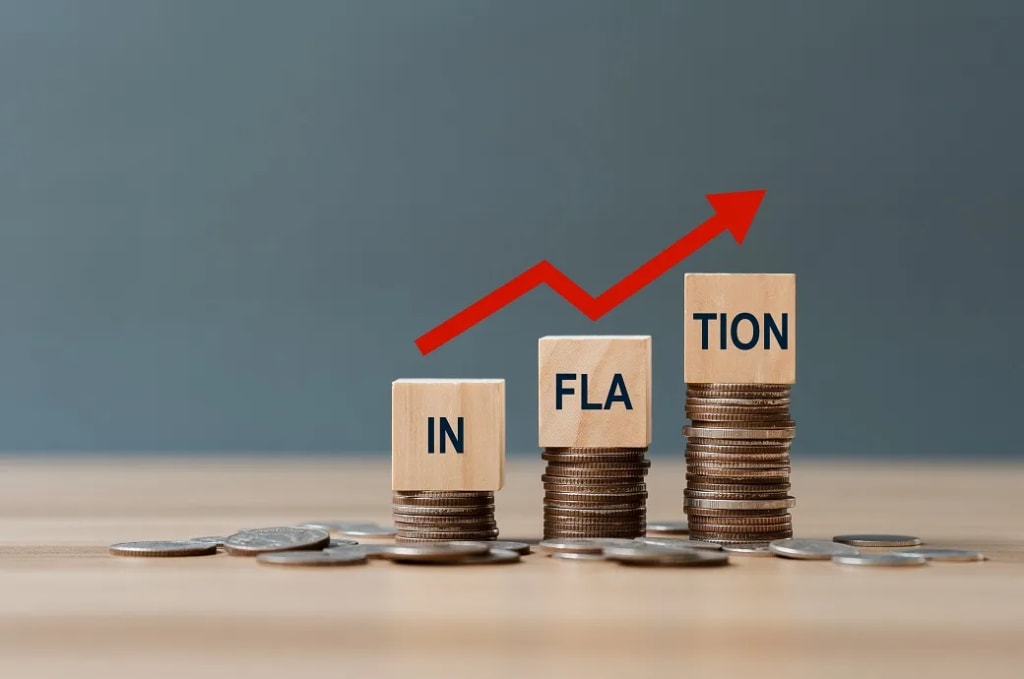
Inflation is the rate at which the general level of prices for goods and services is rising, and, subsequently, purchasing power is falling. It is measured by tracking changes in the prices of a basket of goods and services over time, usually using a consumer price index (CPI).
Inflation can be caused by various factors, including an increase in demand for goods and services, a decrease in supply, or changes in the cost of production. Monetary policy, such as changes in interest rates or the money supply, can also affect inflation.
Inflation can have both positive and negative effects on an economy. High levels of inflation can erode the purchasing power of consumers, reduce investment, and discourage foreign investment. However, moderate inflation can encourage spending, investment, and economic growth.
Central banks typically try to keep inflation at a moderate level, often targeting an inflation rate of around 2%. They use various tools, such as adjusting interest rates or the money supply, to achieve this goal.
Inflation is a macroeconomic concept that refers to the general rise in prices of goods and services in an economy over a period of time. It can be measured by calculating the percentage change in the price level of a basket of goods and services in a given time period, usually a year.
There are two main types of inflation:
Demand-pull inflation: This occurs when there is too much demand for goods and services relative to the available supply, leading to an increase in the general price level.
Cost-push inflation: This occurs when the cost of producing goods and services increases, and the higher production costs are passed on to consumers in the form of higher prices.
Inflation can be caused by various factors, including:
Increases in the money supply: When there is more money in circulation, consumers have more money to spend, which can lead to an increase in demand for goods and services, pushing up prices.
Increases in demand: When there is an increase in demand for goods and services, producers can raise prices, leading to inflation.
Decreases in supply: When there is a decrease in the supply of goods and services, producers can raise prices, leading to inflation.
Inflation can have both positive and negative effects on an economy. Some of the negative effects of high inflation include:
Reduced purchasing power: High inflation reduces the purchasing power of consumers, making it more expensive to buy goods and services.
Reduced investment: High inflation can discourage investment, as investors may be uncertain about the future value of their investments.
Increased uncertainty: High inflation can create economic uncertainty, making it difficult for businesses and consumers to plan for the future.
However, moderate levels of inflation can have some positive effects, such as:
Encouraging spending: Moderate inflation can encourage consumers to spend money, as they may expect prices to rise in the future.
Encouraging investment: Moderate inflation can encourage investment, as investors may expect to earn a return on their investment that is higher than the rate of inflation.
Central banks often try to maintain a moderate level of inflation, usually around 2-3%, using various monetary policy tools, such as adjusting interest rates or the money supply. By doing so, they aim to promote economic growth while keeping inflation under control.
Regenerate response
There can be several reasons for an increase in inflation:
1.Increase in demand: When there is an increase in demand for goods and services, producers may raise prices to take advantage of the situation, leading to inflation.
2.Increase in production costs: When the cost of producing goods and services increases, producers may pass on the higher costs to consumers in the form of higher prices, leading to inflation. This can happen due to factors such as higher raw material prices, higher wages, or higher taxes.
3.Increase in the money supply: When there is an increase in the money supply, consumers have more money to spend, leading to an increase in demand for goods and services and pushing up prices.
4.Depreciation of currency: When the value of a country's currency decreases relative to other currencies, the cost of imported goods increases, which can lead to inflation.
5.External shocks: Natural disasters, wars, or other external events can disrupt the supply chain, causing shortages of goods and services, which can lead to inflation.
It's worth noting that a moderate level of inflation is generally considered desirable as it can help encourage spending and investment. However, high levels of inflation can be harmful to the economy, as it can lead to a decrease in purchasing power, discourage investment, and increase uncertainty. Central banks and governments use various policies and tools to manage inflation and maintain price stability.
About the Creator
Paramjeet kaur
Hey people! I am my own person and I love blogging because I just love to share the small Stories






Comments
There are no comments for this story
Be the first to respond and start the conversation.